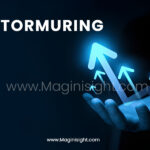In today’s fast-shifting business world, the term stormuring has emerged as a compelling concept that perfectly captures the essence of modern transformation. Stormuring combines the words storm and maturing, symbolizing a phase where disruption meets evolution — where chaos doesn’t destroy but instead reshapes, strengthens, and matures organizations. It is not just about surviving the storm of innovation; it’s about using that storm to grow stronger, smarter, and more adaptable.
In an age where every business faces constant turbulence — from AI revolutions and automation to global digitalization — stormuring becomes the mindset that separates thriving enterprises from those that fade away. It is the disciplined art of turning disruption into development, instability into insight, and change into continuity. Businesses that master stormuring do not resist transformation; they architect it, turning challenges into opportunities for long-term maturity and resilience.
This article explores stormuring in depth — its definition, origin, strategic importance, and its growing role in driving sustainable digital transformation and innovation management across industries.
Understanding Stormuring — The Fusion of Disruption and Maturity
The word stormuring might sound abstract at first, but it represents a deeply relevant framework for businesses navigating rapid change. Traditionally, disruption and maturity have existed at opposite ends of the business spectrum — one symbolizes chaos, while the other signifies stability. Stormuring bridges these extremes, showing how both forces can coexist and complement each other.
At its core, stormuring teaches organizations that evolution is not linear. Every wave of disruption — whether technological, cultural, or economic — brings an opportunity to rethink strategies, processes, and customer experiences. Stormuring encourages companies to embrace volatility as a growth catalyst, integrating it with mature governance, culture, and systems.
For example, a tech company that continually reinvents its digital platforms while maintaining operational stability demonstrates stormuring in action. It’s about finding that delicate balance between innovation speed and organizational maturity, ensuring that progress doesn’t lead to chaos but to continuous improvement.
The Origin and Concept Behind Stormuring
The concept of stormuring stems from the realization that traditional business models cannot withstand the pace of digital disruption. Over the past decade, industries have witnessed repeated cycles of transformation — cloud computing, AI, blockchain, IoT, and now, generative intelligence. Each wave of innovation brings both opportunities and uncertainties. Companies that evolve during these storms mature faster than those that cling to outdated structures.
“Stormuring” symbolizes strategic adaptability — the ability to move with the storm rather than against it. Instead of fearing change, organizations that adopt stormuring leverage disruption to accelerate maturity. They create ecosystems that learn, evolve, and self-correct in real time.
In essence, stormuring is not just about weathering storms but learning from them. It pushes leaders to rethink how they approach crisis, risk, and transformation. It promotes a growth mindset that blends innovation energy with disciplined structure — the hallmark of future-ready enterprises.
The Dual Nature of Stormuring — Storm Meets Structure
Stormuring stands at the intersection of two powerful forces: storm and maturing. The “storm” represents the turbulence of innovation — the chaos that comes with new technologies, shifting markets, and disruptive ideas. The “maturing” reflects structure, wisdom, and strategic resilience.
When these two dynamics converge, they create a cycle of sustainable reinvention. Companies experience controlled chaos — a rhythm where they continuously innovate but maintain operational clarity. This is what distinguishes stormuring from mere digital disruption. It’s not just reacting to change; it’s architecting it with foresight and discipline.
From a leadership standpoint, stormuring requires balancing bold experimentation with governance. It calls for flexible systems that can adapt rapidly, yet remain stable enough to protect brand trust and customer relationships. Businesses that embrace this mindset become agile giants — capable of both scaling fast and evolving gracefully.
Digital Transformation and Innovation Management
Digital transformation is no longer a one-time project; it’s an ongoing journey. This is where stormuring becomes a guiding principle. It helps organizations design transformation strategies that are dynamic, resilient, and future-proof.
A stormuring-driven transformation focuses on three pillars:
-
Adaptive Strategy: Businesses that practice stormuring treat strategy as a living framework. They continuously refine their goals in response to technological shifts and market signals.
-
Innovative Agility: Instead of pursuing innovation for its own sake, stormuring encourages purposeful innovation — solutions that align with long-term vision and deliver measurable impact.
-
Operational Resilience: As systems evolve, companies strengthen governance and data integrity, ensuring that digital disruption enhances rather than jeopardizes performance.
Stormuring thus becomes the bridge between rapid innovation and sustainable success. It’s how businesses evolve without losing their essence — staying disruptive yet dependable, bold yet balanced.
Stormuring in Business Growth and Organizational Strategy
In today’s hyperconnected world, stormuring has become a critical principle for sustainable business growth. Organizations can no longer rely on static models or predictable cycles. Market shifts occur overnight, customer expectations evolve in real time, and innovation cycles are shortening dramatically. In this environment, stormuring empowers companies to navigate uncertainty while maturing strategically.
Instead of pursuing growth at all costs, stormuring-driven companies build resilient growth ecosystems. They focus on creating adaptable structures that can flex and evolve as the business landscape changes. For example, companies that successfully transitioned from traditional retail to digital-first platforms did so through stormuring — embracing disruption while embedding long-term scalability into their DNA.
The strategic essence of stormuring lies in dynamic alignment — aligning innovation, culture, and operations with a shared vision that evolves continuously. Businesses practicing stormuring foster cross-functional collaboration, integrate data intelligence into every decision, and empower employees to act as innovation catalysts. This fusion of disruption and maturity enables not just faster growth but smarter, sustainable progress.
How Stormuring Redefines Leadership and Corporate Culture
Leadership in the age of stormuring demands a new mindset. Gone are the days when stability meant safety; today, stagnation is risk. Modern leaders must be comfortable leading through ambiguity, managing paradoxes, and guiding their teams through transformation waves.
A stormuring leader doesn’t suppress disruption — they orchestrate it. They create an environment where creative chaos is structured, where ideas can collide and evolve within a safe framework of governance. This requires emotional intelligence, strategic foresight, and the humility to unlearn outdated practices.
In organizational culture, stormuring translates into psychological safety and adaptive learning. Teams are encouraged to experiment, fail fast, and pivot efficiently. Instead of penalizing mistakes, stormuring cultures treat them as data — valuable inputs for collective growth. The result is a company that’s constantly maturing through storms, capable of reinventing itself before external forces demand it.
Forward-thinking corporations like Microsoft, Netflix, and Amazon have displayed stormuring principles by evolving business models repeatedly while maintaining cultural consistency. Their success proves that adaptability anchored in maturity builds enduring value.
The Mechanics of Stormuring — Framework and Implementation
Implementing stormuring within an organization involves both structural and mindset shifts. It’s not a one-time process; it’s a continuous evolution model based on three interdependent stages:
-
Recognition of the Storm:
The first step is identifying emerging disruptions — technological, market-based, or internal. Stormuring requires proactive sensing of shifts before they become threats. -
Integration into Strategy:
Once identified, the disruption is not resisted but integrated into the company’s strategy. This could mean rethinking workflows, investing in automation, or redefining customer engagement models. -
Maturing Through Learning:
The final stage involves institutional learning — transforming the lessons from each disruption into frameworks, best practices, and governance standards. This ensures that every storm contributes to organizational maturity.
A well-executed stormuring strategy combines agility with accountability. It empowers innovation teams to explore while maintaining enterprise-wide consistency in data, ethics, and brand values.
In practical terms, stormuring-driven organizations invest in real-time analytics, digital upskilling, and modular business architectures. These tools enable them to adapt continuously without losing coherence.
Stormuring and the Role of Technology
Technology acts as both the catalyst and the compass of stormuring. From AI to edge computing, digital disruption is the storm — and strategic integration is the maturing. Businesses that effectively combine these forces can outpace competition while building resilience for the future.
For instance, the implementation of AI-powered automation can initially cause workflow disruption. But through stormuring, companies turn this chaos into capability — retraining employees, optimizing processes, and unlocking new efficiencies. Similarly, adopting cloud-native infrastructures or data-driven ecosystems brings short-term instability but long-term flexibility and scalability.
Stormuring also promotes technology-human synergy. Instead of replacing human creativity, it augments it. This approach creates organizations that are technologically empowered but human-centered — an essential formula for sustainable digital maturity.
Moreover, the stormuring mindset drives better cyber resilience and data governance. When companies mature through digital storms, they develop stronger protocols, smarter infrastructure, and a deeper understanding of how to manage digital risk responsibly.
Stormuring in Innovation Ecosystems
In innovation management, stormuring is the foundation for long-term creative stability. Innovation itself is a storm — unpredictable, fast-moving, and sometimes destructive. But through stormuring, businesses channel that storm toward measurable and meaningful growth.
An innovation ecosystem built on stormuring principles encourages iterative progress instead of isolated breakthroughs. Startups and corporations alike benefit from viewing innovation as a maturity process — not a random spark but a system of continuous experimentation, testing, and scaling.
Consider how Google’s “20% innovation time” or Tesla’s agile engineering approach aligns with stormuring. These methods thrive on chaos yet are backed by structured feedback loops and disciplined scaling. Stormuring ensures that creativity does not dissolve into confusion but evolves into consistent advancement.
It also transforms innovation culture from “reactive” to “proactive.” Instead of chasing trends, stormuring organizations anticipate them — creating the next wave of transformation while others are still adjusting to the last one.
Challenges in Applying Stormuring
While stormuring offers immense potential, it is not without challenges. The first barrier is organizational inertia — the resistance to change embedded in traditional hierarchies. Mature systems can struggle to accommodate disruptive thinking. Overcoming this requires courageous leadership and a willingness to dismantle outdated models.
Another challenge is balancing speed with stability. Too much innovation without structure leads to burnout and misalignment; too much structure stifles creativity. Stormuring demands precision in maintaining that balance.
Furthermore, talent transformation is critical. Teams must develop digital literacy, systems thinking, and emotional resilience to thrive amid constant change. Without investing in people, stormuring risks becoming just another buzzword rather than a lived philosophy.
Lastly, measuring stormuring success can be complex. Traditional KPIs rarely capture adaptability or learning velocity. Companies must design new performance metrics focused on resilience, responsiveness, and innovation maturity.
Real-World Examples in Action
To understand stormuring beyond theory, we can examine organizations that have mastered the art of evolving through disruption while maintaining long-term maturity. These companies didn’t just survive turbulent transformations — they grew stronger through them.
1. Microsoft’s Reinvention Through Cultural Stormuring
When Satya Nadella became CEO, Microsoft was facing stagnation. The company’s structure was rigid, innovation had slowed, and internal competition had replaced collaboration. Nadella introduced what can be called a “stormuring mindset.” He embraced cloud computing, open-source development, and an empathetic culture of learning.
Under his leadership, the “storm” of change was integrated into the company’s DNA. Microsoft matured into a more collaborative, agile, and cloud-centric organization, transforming from a software giant into a platform and services ecosystem. That balance of innovation and stability — chaos and structure — is pure stormuring in motion.
2. Netflix: Navigating Market Disruption With Stormuring
Netflix has redefined stormuring through its ability to evolve without losing focus. It transitioned from DVD rentals to streaming and then to global content production. Each pivot was a storm, yet Netflix managed to mature its technology, analytics, and creative processes at every stage.
Through constant reinvention, it turned each disruption into a competitive advantage. Netflix’s ability to adapt its business model while retaining brand identity demonstrates how stormuring can drive continuous evolution without compromising maturity.
3. Tesla: Disruption as a Discipline
Tesla operates in a constant state of stormuring. Every product launch, factory expansion, and technology update is a calculated disruption followed by rapid learning and system refinement. Tesla’s approach exemplifies controlled chaos — innovation governed by a clear mission.
From battery technology to autonomous driving, Tesla’s maturity lies not in stability but in its ability to thrive amid continuous transformation. Its process-driven innovation cycle — experiment, fail, improve, scale — embodies the spirit of stormuring.
4. Amazon: The Architecture of Constant Evolution
Amazon’s leadership principles revolve around stormuring — the relentless pursuit of innovation balanced by customer obsession and operational discipline. Its ecosystem expands continuously, from e-commerce to AWS and AI-driven logistics, yet the company sustains a strong structural maturity.
This duality of endless experimentation and strict efficiency allows Amazon to absorb disruptions, learn from them, and mature faster than competitors. Stormuring, in Amazon’s case, is not a project — it’s a philosophy embedded in every process.
Stormuring and Personal Development
While stormuring is often discussed in corporate and technological contexts, its principles are equally transformative on an individual level. Personal stormuring is about embracing life’s disruptions as opportunities for emotional, intellectual, and professional growth.
Just as companies mature through storms, individuals can evolve by reframing challenges as catalysts for self-improvement. When a person experiences uncertainty — such as career transitions, failures, or technological changes — stormuring encourages them to respond with adaptability, learning, and composure.
The personal stormuring mindset includes:
-
Curiosity over fear: Viewing change as an invitation to explore rather than a threat to stability.
-
Continuous learning: Committing to skill development and growth in the face of disruption.
-
Emotional maturity: Developing resilience and self-awareness to maintain focus amid chaos.
-
Strategic patience: Understanding that true maturity takes time, even when the world moves fast.
In the future of work — defined by automation, hybrid structures, and AI collaboration — stormuring will be a critical personal competency. Professionals who master this mindset will not only survive digital disruption but shape its outcomes.
The Future of Stormuring — A Blueprint for the Next Digital Decade
As we enter a new era driven by AI, quantum computing, and decentralized ecosystems, stormuring will become a guiding principle for future-ready enterprises. The next decade of business transformation won’t be about technology alone — it will be about how organizations integrate disruption into sustainable progress.
Here’s what the future of stormuring looks like across key dimensions:
1. AI and Stormuring
Artificial intelligence represents the ultimate storm — a technology capable of reshaping every industry. But stormuring teaches that AI maturity requires ethics, transparency, and governance. Companies that stormure successfully with AI will pair innovation with responsibility, using automation to enhance human decision-making rather than replace it.
2. Decentralized and Modular Organizations
Future enterprises will operate in networks rather than hierarchies. Stormuring will guide how businesses build modular systems that can reconfigure quickly in response to new market realities. Agility will no longer be optional — it will be the structure itself.
3. Sustainability Through Stormuring
Environmental and social challenges represent global disruptions. Applying stormuring means developing business models that evolve sustainably — aligning economic performance with environmental maturity. Circular economies, green technologies, and ethical supply chains all represent stormuring at scale.
4. Human-Centric Digital Transformation
Despite rapid automation, the human element remains central. Stormuring ensures that digital strategies remain people-focused — designing systems that support well-being, inclusion, and purpose. This balance between technological advancement and human empathy defines the next generation of mature innovation.
How Organizations Can Start
Embracing stormuring is a journey, not a checklist. Organizations that want to adopt this model can begin with five foundational practices:
-
Redefine Leadership Philosophy: Encourage adaptive, empathetic, and collaborative leadership that thrives in uncertainty.
-
Establish Feedback-Driven Learning Loops: Create systems where data, performance insights, and customer feedback continuously shape strategy.
-
Invest in Organizational Agility: Develop cross-functional teams and flexible processes that can pivot quickly when disruption hits.
-
Build Cultural Resilience: Promote open communication, trust, and learning from failure — the emotional infrastructure of stormuring.
-
Integrate Technology with Purpose: Use innovation not for trend-following but for meaningful transformation that aligns with the organization’s core mission.
When these principles become daily practice, stormuring ceases to be a buzzword and becomes a living part of corporate DNA.
Why Stormuring Is the Competitive Advantage of the Future
In an economy defined by volatility, the greatest competitive advantage is adaptability. Stormuring transforms adaptability into a system — a repeatable process that converts instability into innovation.
Companies that master stormuring can scale faster, recover quicker, and innovate smarter. They don’t fear technological storms — they engineer them. This mindset redefines success in modern business: not the ability to predict change, but the capacity to evolve through it.
Stormuring, therefore, becomes the language of resilience, the architecture of reinvention, and the foundation of lasting relevance in the digital era.
Conclusion
The journey of stormuring teaches a timeless truth: growth does not happen in comfort; it happens in motion. Whether in business, technology, or personal life, every storm carries seeds of evolution. The organizations and individuals who learn to harness those storms will define the future.
As digital transformation accelerates, stormuring emerges not just as a concept but as a necessity — the disciplined maturity of disruption. It reminds us that chaos, when navigated with wisdom, leads to creation; that turbulence, when managed with vision, drives progress.
Stormuring is not about waiting for the storm to pass — it’s about learning to mature within it. And that, ultimately, is how great innovators, leaders, and enterprises are built.
Don’t miss out on any news—keep in touch for real-time information, visit Mag Insight








